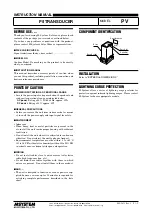
10JM
5-2-55, Minamitsumori, Nishinari-ku, Osaka 557-0063 JAPAN
Phone: +81(6)6659-8201 Fax:
+81(6)6659-8510 E-mail: [email protected]
EM-0865 Rev.5 P. 3 / 5
CHECKING
1 ) Terminal wiring: Check that all cables are correctly con-
nected according to the connection diagram.
2 ) Power input voltage: Check voltage supplied to the rack
(model: 10BXx). For the DC power source, be sure that
the ripple level is within 10% p-p.
3 ) Output: Check that the load resistance meets the de-
scribed specifications.
ADJUSTMENT PROCEDURE
This unit is calibrated at the factory with the total resist-
ance input, therefore you do not need any calibration if you
use the potentiometer’s total resistance.
When you don’t use the total resistance or in case of regular
calibration, adjust the output as explained in the following.
Zero and span are adjusted with using the Programming
Unit (model: PU-2x). Also, fine adjustments for the Output
2 can be done with the potentiometers on top of the unit
which are accessible using Extender Card (model: 10EC)
maintaining electrical connection to the rear connector.
Refer to the Operation Manual for Model PU-2x for expla-
nations how to use the programmer.
■
WARNING ON USE OF THE PROGRAMMING UNIT
•
Be sure to disconnect the Programming Unit before you
turn on/off power supply to the unit.
•
The output signal is held when the Programming Unit is
connected. You need to disconnect when confirming cur-
rent output values.
■
HOW TO CALIBRATE THE OUTPUT 1
Use a signal source and measuring instruments of sufficient
accuracy level. Turn the power supply on and warm up for
more than 10 minutes.
•
Fine Output Calibration
Using the Programming Unit (ITEM 19, 20)
ITEM 19 is for Zero, and ITEM 20 is for Span.
1 ) Turn the unit into Program mode (ITEM 01).
2 ) Apply simulated 0% input. Increase/decrease values
(default: 0%) at ITEM 19 until the output signal is cali-
brated to actual 0%.
3 ) Apply simulated 100% input. Increase/decrease value
(default: 100%) at ITEM 20 until the output signal is
calibrated to actual 100%.
4 ) Apply simulated 0% input again and check 0% output.
5 ) When 0% value is changed, repeat the above procedure
2) - 4).
The 0% value may be shifted when the output span is
greater than the input span (gain > 1).
■
HOW TO CALIBRATE THE OUTPUT 2
Use Extender Card (model: 10EC) to access the Output 2
Adjustments on top of the unit.
1 ) ZERO: Apply 0% input and adjust output to 0%.
2 ) SPAN: Apply 100% input and adjust output to 100%.
3 ) Check ZERO adjustment again with 0% input.
4 ) When ZERO value is changed, repeat the above proce-
dure 1) – 3).
■
Calibrating the Output Range Proportionally to the
Actual Input Resistance Range
The output range can be calibrated for input ranges nar-
rower than the total resistance, to match the actual input
resistance range, by using the linearization table (ITEM 60
through 91) to compensate unused resistance ranges (See
the following figures).
If upper and lower overranges need not to be considered,
only two calibration points will suffice.
X(02)
X(01)
0%
Y(02)
100%
Y(01)
OUTPUT
INPUT
(a), (c) : Unused Resistance
= (Total Resistance – Input Resistance)
(b) : Input Resistance
= Actual Resistance Range
100%
(a)
(b)
(c)
Figure 1. Unused Resistance
X(02)
X(01)
0%
100%
Y(02)
Y(01)
OUTPUT
INPUT
(b)
(b) : Input Resistance
= Actual Resistance Range
Figure 2. Example of Linearization
1 ) Confirm actual lower-range and upper-range resist-
ance in percentage against the total resistance range
0 – 100%.
In order to do this, provide actual resistance values and
confirm them on the Programming Unit (ITEM 05: In-
put Status Monitor in %).
2 ) Turn the unit into Program mode (ITEM 01).
3 ) Enable use of the linearization table (ITEM 10: Pm-2 :
curved).
4 ) Set the lower-range input in % at ITEM 60.
5 ) Set the lower-range output in %, usually ‘0’ (zero), at
ITEM 61.
6 ) Set the upper-range input in % at ITEM 62.
7 ) Set the upper-range output in %, usually ‘100’, at ITEM
63.























